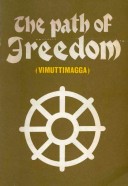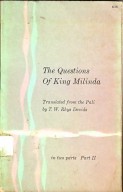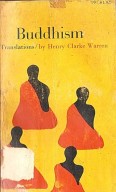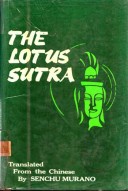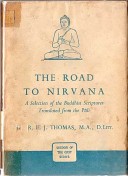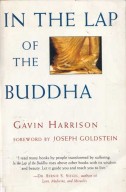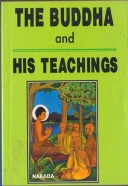Tìm Sách
Sách tiếng Anh-English >> The Path of Freedom (Vimuttimagga)
Thông tin tra cứu
- Tên sách : The Path of Freedom (Vimuttimagga)
- Tác giả : The Arahant Upatissa
- Dịch giả : The Venerable Soma Thera
- Ngôn ngữ : Anh
- Số trang : 326
- Nhà xuất bản : Ceylon
- Năm xuất bản : 1961
- Phân loại : Sách tiếng Anh-English
- MCB : 1210000003576
- OPAC :
- Tóm tắt :
PREFACE
As stated elsewhere (In Memoriam (p. XV) the draft translation of the Gedatsu Do Ron (being the Chinese name for the Vimuttimagga) was completed in four months. Therefore it was thought that it needed some revision. This the Venerable Soma Thera intended to do on his return to Ceylon in 1937. But he fell ill and by the end of 1939 the Second World War was already three months old. All hope of publishing the revised edition of the Original Draft Translation during the war had to be given up. With the end of the war, however, conditions were even less favourable. Meanwhile, though the Venerable Soma Thera wished to complete the revision and await a favourable occasion to publish it, other work he had undertaken prevented him from doing so. Further, asthma robbed him of much of his time. Thus the work he intended to do on the Vimuttimagga translation had to be postponed each time he took it up.
When he passed away many venerable theras and dăyakas were much interested in publishing, at least, the Original Draft Translation as it was, and they requested me to prepare it for publication. Knowing my own limitations, I was at first rather disinclined to undertake this work, but later acceded to their earnest request for the following reasons.
The Venerable Soma Thera had originally wished to have the English translation of the Vimuttimagga (The Path of Freedom) revised and published some day. But later, seeing difficulties, he modified the idea and was even content with merely revising the Draft Translation, leaving the publication itself to some future time. He said that the important thing, the Draft Translation, had been done, and that if people felt that they needed it they would see to its publication.
It was a work that had inspired both the Venerable Soma Thera and me, and there were many who welcomed its publication.
Dr. D. Roland D. Weerasuria of Baicombe House, Balcombe Place, Colombo, invited the Venerable Soma Thera sometime in 1959 to write an abridged version of the Visuddhimagga as he felt that such an edition would supply a long felt want. But shortly after he began writing it death intervened. Dr. Weerasuria then requested the Venerable 5íãọamoli Thera to take up the work which, after some hesitation, he agreed to finish within a year. But he, too, passed away within a week. Sometime after this Dr. Weerasuria, having seen the Original Draft Translation of the Vimuttimagga, was keen on its publication.
This was a fitting occasion to pay a tribute to the memory of the two senior co-translators of the Vimuttimagga, the Reverend N. R. M. Ehara and the Venerable Soma Mahã Thera.
And finally the urgent personal need to keep myself immersed in the Dhamma throughout the waking hours during this period of stress prompted me to take up the work.
From the above it will be seen that this work was taken up due to sheer force of circumstances and not because of any special qualification on my part. Therefore, perhaps, some things stated here could have been said in other and better ways. Inexpert as I am in scholarly persuits there is bound to be many a lack in my portion of this work and so I ask reader to bear with me should he detect any errors of commission or omission here.
In preparing this work for printing I have made a few alterations in the rendering of certain terms and passages, as they appeared in the Original Draft Translation, in accordance with notes and instructions left by the Venerable Soma Thera. The lacunae in the Draft Translation were filled, as far as possible, with the help of the word for word translation in consultation with Soma Thera’s notes. AH the longer Pali quotations in the footnotes, except a few from the Visuddhimagga and some from the Dhammasangani etc., were inserted by me. They are given in full mainly with the idea of helping the general reader conversant with the Pali but to whom reference books are not easily accessible. By this attempt of mine if but just a few readers happen to be benefited, to any extent, I should consider myself amply rewarded.
Since the Introduction had already been sent to the Printers by the time the Encyclopaedia of Buddhism (1961 Government of Ceylon, Fascicule A-Aca) was out, the following is included here. In his article, Abhidharma Literature, Dr. Kogen Mizuno makes three statements on page 78 of the Encyclopaedia regarding the Vimuttimagga: (1) that the Vimuttimagga (along with the Dhammapada, the Atthakavagga of the Suttanipãta etc.) “probably belonged to the Abhayagiri sect and not to the Mahavihara sect” (paragraph B continued from the previous page); (2) that “He (i, e., the Venerable Buddhaghosa Thera) evidently studied the Vimuttimagga, which was a manual of the Abhayagirivihara sect” (paragraph c); and (3) “That the Vimuitimagga, was Upatissa’s work and belonged to the Abhayagirivihăra sect is mentioned in the tỉkã (sub-commentary, i.e., Dhammapala’s Paramattha- manjusa) of the Visuddhimagga” (paragraph c).
The first statement, (l) above, says that the Vimuttimagga “probably belonged to the Abhayagiri sect”, while the second, (2) above, says “Vimuttimagga, which was a manuel of the Abhayagirivihara sect”. How, precisely, did probability in paragraph B became certainty in paragraph c? As for the third statement, (3) above, the Paramatthamanjusã does not say that the Vimutiimagga “belonged to the Abhayagirivihara sect” as is claimed here. What it says is that the Vimuttimagga is the work of the Venerable Upatissa Thera. The fact that certain teachings are common to both the Abhayagirivihãra and the Vimuttimagga does not prove that the latter belonged to the Abhayagirivihãra sect. For details see Introduction pp. XXXVI, XXXVII and n. 2, p. 57 of the present translation.
I have derived much help from Prof. Dr. P. V. Bapat’s Vimuttimagga and Visuddhimagga—a Comparative Study, and the Venerable Nãnamoli Thera’s translation of the Visuddhdimagga—The Path of Purification. The Pali Text Society’s Pali-English Dictionary 1921, and Trenchner’s Critical Pali Dictionary, Copenhagen 1924-1948 have been equally helpful.
It is with great pleasure that I make the following acknowledgements to all those whose help and encouragement made my work less difficult.
To the Venerable Madihe Pannãsĩha Mahã Nãyaka Thera of Vajirarãma for his kindly and ready help and advice at all times lacking which this work would not have been completed.
To all those venerable monks who encouraged me by word and deed when that encouragement was most needed.
To the Venerable Nanavira Thera for his welcome suggestions and the readiness with which he helped in many ways.
To Mr. W. Joseph Soysa who helped in reading over some of the proofs. He has always been much interested in the Vimuttimagga and in its publication.
To Mr. Lakshman de Mel who read through the type-script and made valuable suggestions.
To Mr. R. D. Piyasena and those who helped him for taking a great deal of trouble in preparing the English Index.
Lastly, to Dr. D. Roland D. Weerasuria who has generously borne the entire cost of publishing this translation. Provision has been made by him to keep the price of this book within reach of the modest purse. He has performed this meritorious act (punnakamma) with great faith (saddha) wishing his father, Mudaliyar D. D. Weerasuria J.P., who passed away on 25. 5. 1949, the happiness of Nibbana. May the result of this pure deed redound in full measure to his lasting happiness.
The Printers have to be thanked for their patience and high quality of work.
Vijirarama, KHEMINDA THERA,
Colombo, Ceylon October 2505/1961
CONTENTS
FASCICLE I, CHAPTER I – INTRODUCTORY DISCOURSE
Salutation
Introductory Stanza
Path of Freedom Described
Merits of Acknowledgement of the Path
Three Trainings
Meaning of Training
Removal of the Impurities
The Three Kinds of Good
The Three Kinds of Happiness
Perfection of the Middle Way
CHAPTER II – ON DISTINGUISHING VIRTUE
Virtue Defined
Salient Characteristic of Virtue
Function, Manifestation, Near Cause of Virtue
Benefits of Virtue
Meaning of Virtue
Virtue and Mode of Life
Three Kinds of Virtue
What Produces Virtue
Stages of Virtue
Impediments and Causes of Virtue
Groups of Virtue (Various)
What Purifies Virtue
Causes Through Which One Dwells in Virtue
FASCICLE II, CHAPTER III – ON AUSTERITIES
The Thirteen Austerities
Brief Explanation of the Thirteen Austerities
‘Dirt –rags’
‘Three Robes’
‘Begged Food’
‘Regular Alms-round’
‘One-eating’
‘Measured Food’
‘No Food After Time’
‘Dwelling in a Peaceful Place’
‘Dwelling Under a Tree’
‘Dwelling in a Dewy Place’
‘Dwelling Among Graves’
‘Any Chanced upon Place’
‘Always Sitting and Not Lying Down’
‘Expedience in the Observance of the Austerities
Miscellaneous Teachings
CHAPTER IV – ON DISTINGUISHING CONCENTRATION
Meaning of Concentration
Salient Characteristic etc.
Benefits Produced by Concentration
Obstacles to Concentration
Causes of Concentration
Requisites of Concentration
Kinds of Concentration (Various)
Why Four and Five Meditations are Taught
CHAPTER V – ON APPROACHING A GOOD FRIEND
Qualities of a Good Friend
The Search for a Good Friend
A Beginner’s Duties
FASCICLE III, CHAPTER VI – THE DISTINGUISHING OF BEHAVIOUR
Kinds of Behaviour
Fourteen Kinds of Persons
Fourteen Kinds Reduced to Seven
Modes of Practice
Seven Reduced to Three
Causes of Behaviour
Elements as Causes of Behaviour
The Humours as Causes of Behaviour
Seven Aspects of Behaviour
On Robing, Begging, Sitting, Sleeping, and Resort
Miscellaneous Teachings
CHAPTER VII – THE DISTINGUISHING OF THE SUBJECTS OF MEDITATION
Thirty-eight Subjects of Meditation
Method of Discerning the Qualities
By Way of Meditation
By Way of Transcending
By Way of Increasing
By Way of Cause
By Way of Object
By Way of Speciality
By Way of Plane
By Way of Seizing By Way of Person
FASCICLE IV, CHAPTER VIII, SECTION I – ENTRANCE INTO THE SUBJECT OF MEDITATION
Earth Kasipa, Its Practice, Salient Characteristic, Function and Near Cause
Benefits
Meaning of Kasipa
Kinds of Earth
Non-Prepared Earth
On Making a Mapdala
Method of Earth Kasipa Meditation
Tribulations of Sense-Desires Illustrated in Twenty Similes
Renunciation and Its Benefits
Method of Practice of Earth Kasipa
Three Ways of Sign-Taking
Grasping Sign
The After-Image
The Sign
Protecting the Sign
Access-Meditation
Fixed Meditation, Jhana
Increasing the Kasina
Skilfulness in Fixed Meditation, Jhana
Ten Ways
Simile of the Horse-Chariot Simile of the Inked-String
The First Meditation, Jhana
Three Kinds of Separation From Lust arid Demeritorious States
Two Kinds of Lust
Roots of Demerit
Reasons for Treating Lust and Demerit Separately
Separation From Demeritorious States
Difference Between Lust and Demerit
Initial and Sustained Application of Thought
Initial and Sustained Application of Thought Discriminated
Similes of the Bell etc.
Similes of the Bird etc.
Solitude
Joy and Bliss
Five Kinds of Joy
Bliss
Five Kinds of Bliss
Difference Between Joy and Bliss
First Meditation, (Jhãna)
Five Hindrances
Five Factors
Similes of Chariot and Army
Three Kinds of Goodness
Ten Characteristics
Twenty-five Benefits
Simile of the Bath-Attendant
Three Kinds of Rebirth
Meditation Which Partakes of Deterioration, Stability, Distinction and Penetration
FASCICLE V, CHAPTER VIII, SECTION II
The Simile of the Young Cow
Entrance Into the Second Meditation, Jhãna
Smile of the Pool of Water
The Third Meditation, Jhana
Simile of the Calf
Simile of the Lotus Pond
The Fourth Meditation, Jhana
Simile of the White Cloth
The Sphere of the Infinity of Space
The Concentration of the Sphere of Infinite Consciousness
The Sphere of Nothingness
The Sphere of Neither Perception Nor Non-Perception
Miscellaneous Teachings
The Water Kasina
The Fire Kasina
The Air Kasina
The Blue-Green Kasina
The Yellow Kasina
The Red Kasina
The White Kasina
The Light Kasina
FASCICLE VI, CHAPTER VIII, SECTION III
The (Separated) Space Kasina
The Consciousness Kasina
Miscellaneous Teachings
THE TEN PERCEPTIONS OF PUTRESCENCE
- The Perception of Bloatedness
- The Perception of Discolouration
- The Perception of Festering
- The Perception of the Fissured
- The Perception of the Gnawed
- The Perception of the Dismembered
- The Perception of the Cut and the Dismembered
- The Perception of the Blood-Stained
- The Perception of Worminess
- The Perception of the Bony
Miscellaneous Teachings
The Recollection of the Buddha
The Recollection of the Law
The Recollection of the Community of Bhikkhus
The Recollection Virtue
The Recollection of Liberality
The Recollection of Deities
FASCICLE VII, CHAPTER VIII, SECTION IV
Mindfulness of Respiration
Benefits
Procedure
Counting, Connection, Contacting and Fixing
Sixteen Ways of Training in Mindfulness of Respiration
The Three Trainings
The Four Foundations of Mindfulness
The Seven Enlightenment Factors
Mindfulness of Death
Similes of the Foam, Plantain Trunk and Bubble
Mindfulness of Body
Thirty-two Parts of the Body
Mindfulness in Thirteen Ways
The Worms that Rely on the Body
Bones of the Body
Impurity of the Body
Some Diseases
The Recollection of Peace
Miscellaneous Teachings
FASCICLE VIII, CHAPTER VIII, SECTION V
The Immeasurable Thought of Loving-kindness
Disadvantages of Anger and Resentment
Simile of the Saw
Twelve Means of Removing Hatred
Simile of the Pond
Ten Perfections
The Four Resolves
The Immeasurable Thought of Compassion
The Immeasurable Thought of Appreciative Joy
The Immeasurable Thought of Equanimity
Miscellaneous Teachings
The Determining of the Four Elements
Twenty Ways of Grasping the Element of Earth
Twelve Ways Grasping the Element of Water
Four Ways of Grasping the Element of Fire
Six Ways of Grasping the Element of Air
The Four Elements
Simile of the Puppet
The Loathsomeness of Food
The Dwelling of the Homeless
FASCICLE IX, CHAPTER IX – THE FIVE FORMS OF HIGHER KNOWLEDGE
Three Kinds of Supernormal Power
Seven Kinds of Supernormal Power
Procedure of Developing Supernormal Power
Supernormal Power of Resolve
Supernormal Power of Transformation
Supernormal Power Caused by Mind
Miscellaneous Teachings
Divine Hearing
Knowledge of Others’ Thoughts
Recollection Past Lives
Divine Sight
Miscellaneous Teachings
CHAPTER X – ON DISTINGUISHING WISDOM
Wisdom Defined
Benefits of Wisdom
Meaning of Wisdom
Two Kinds of Wisdom Groups of Wisdom (Various)
FASCICLE X, CHAPTER XI, SECTION I – THE FIVE METHODS
The Aggregate of Form
Four Primaries Defined
Derived Material Qualities
Sense-Organ of Eye
Sense-Organ of Ear
Sense-Organ Nose Sense-Organ of Tongue
Sense-Organ of Body
Difference Between the Four Primaries and Derived Matter
Similes of the Three Sticks
Material Qualities by Way of Arising Material Qualities by Way of Group
Material Qualities by Way of Birth
Material Qualities by Way of Diversity,—Groups of Two in Material Qualities
Groups of Three in Material Qualities
Four Kinds of Material Qualities
Material Qualities by Way of Unity
Aggregate of Feeling
Aggregate of Perception
Aggregate of Formations
Thirty-one Similies
Aggregate of Consciousness
Through Sense-Organ-Object
Through Object
Through States
Through Word Meaning Through Characteristic
Through Discrimination
Through Comprehension
Twelve Sense-Organs and Sense-Objects
Through Word Meaning
Through Limits
Through Condition
Simile of the Thread
Simile of the Mango
Element Method
Conditioned Arising Method
- Direct Order
- Reverse Order
Ignorance
Formations
Simile of the Seeds Simile of the Sun
Simile of the Two Bundles of Reeds
Simile of the Seed, Shoot and Plant
What Conditions Ignorance
Simile of the Colours of a Painter
Conditioned Arising to be Known in Seven Ways
First Three links
Death of the Ignorant Craving Evil-Doer
Action, Action-Sign, Destiny, Destiny-Sign
Four Group Division
Twenty Modes
Direct and Reverse Order
Mundane and Supramundane Conditioned Arising
Four Kinds of Conditioned Arising
Through Comprehension
FASCICLE XI, CHAPTER XI, SECTION II – THE FIVE METHODS
The Four Noble Truths
Truth of
Five Groups of Clinging
Two Kinds of Ill
Three Kinds of Ill
Truth of the Origin of in
Truth of the Cessation of Ill
Truth of the Path Leading to Cessation of Ill
Through Word Meaning
Through Characteristics
Through Series
In Brief
Similes of the Poisonous Tree, The Ship, The Burden
Through Discrimination
Through Enumeration
Through Sameness
Through Difference
Through One Kind etc.
Through Inclusion
CHAPTER XII, SECTION I – ON DISCERNING TRUTH
Aggregates, Elements, Sense-Spheres
Similes of the Three Hundred Halberds and of the Burning Head Procedure
Differences Between Name and Form
Summary of the Truth of Ill
Cause and Condition of Ill
The purity of Transcending Uncertainty
Truth of Cessation
Truth Qf the Path
One Hundred and Eighty Ways of Knowing the Five Clinging Aggregates
Impermanence, Ill, Not-Self
The Signless, the Unhankered, and the Void
The Knowledge of the Rise and Fall
Defilement-Grasp
Concentration-Grasp
Insight-Grasp
Two Ways of Grasping Thought-Characteristics
Characteristics of Rise and Fall in Three Ways
Acquiring the Highest Knowledge
Simile of the Bird Surrounded by Fire Four States
Non-Effort in the Rising of the Formations
Reviewing of Breaking up
Breaking Up in Three Ways— (a) Through assemblage
(b) Through Duality
(c) Through Understanding
Similes of Drum-Sound, Town of Gods, Lightning
FASCICLE XII, CHAPTER XII, SECTION II – ON DISCERNING TRUTH
Fear Knowledge
Similes of the Man with the Sword, Poisonous Snake, and Heap of Fire
Knowledge of the Desire For Release
Adaptive Knowledge
Knowledge of Adoption
Similes of the Boat, Lamp, and Sun
Simile of the Burning City
Three Fetters
Once-Returner
Non-Returner
Saintship
Three Kinds of Stream-Entrant
Five Kinds of Non-Returner
Simile of the Fiery Sparks
Miscellaneous Teachings
Serenity and Insight
Initial Application of Thought and Bare Insight
Joy
Feeling
Plane
Faculties
Các sách khác thuộc Sách tiếng Anh-English
 Facebook
Facebook
 Google
Google
 Google+
Google+
